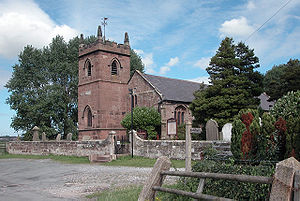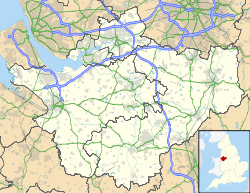- St Peter's Church, Plemstall
-
St Peter's Church, Plemstall 
St Peter's Church, Plemstall, from the southwestLocation in Cheshire Coordinates: 53°13′30″N 2°48′53″W / 53.2251°N 2.8147°W OS grid reference SJ 456 701 Location Mickle Trafford, Cheshire Country England Denomination Anglican Website St Peter's Plemstall History Dedication St Peter Architecture Status Parish church Functional status Active Heritage designation Grade I Designated 1 June 1967 Architectural type Church Style Perpendicular, Gothic Revival Specifications Materials Red sandstone
Welsh slate roofAdministration Parish Plemstall Deanery Chester Archdeaconry Chester Diocese Chester Province York Clergy Rector Rev Mark Hart Laity Reader Pauline Holgate, Barbara King Churchwarden(s) Mike Lowry, Hazel McBriar St Peter's Church, Plemstall stands in an isolated position at the end of a country lane near the village of Mickle Trafford, Cheshire, England. It has been designated by English Heritage as a Grade I listed building.[1] It is an active Anglican parish church in the diocese of Chester, the archdeaconry of Chester and the deanery of Chester. Its benefice is combined with that of St John the Baptist's Church, Guilden Sutton.[2]
Contents
History
The recorded history of the church goes back to the 7th century.[3] It is believed that the present church is built on the site where Plegmund, later Archbishop of Canterbury, lived as a hermit. The surrounding land used to be a marsh and the church stands in a slightly elevated area which was known as "The Isle of Chester".[4] The original church was built in the 12th century but the present building dates mostly from the 15th century. This was financed by the Trafford family who lived locally. A tower was added at the west end in 1826.[5] Inscriptions in the church show that there were restorations in 1684, 1711, 1802–03 and 1819.[4] Death watch beetle was found in some roof rafters and the church was re-roofed in 1958. Electric light was installed in the church in 1966 and central hearing was installed in 1968. Since then a toilet and an entrance for disabled people have been built on to the vestry on the north side.[5] In 2006 new lighting was fitted in the church. The pews were removed from the Barnston Chapel and replaced by modern chairs.[6]
Architecture
Exterior
The church is built in red sandstone with a roof of Welsh slate in late Perpendicular style.[1] The plan consists of a five-bay nave and a chancel in one range, a north aisle with a chapel at its east end, and a south porch.[7] The tower has two bands and a cornice with a castellated parapet and crocketed finials.[1] The porch, which was added in the 16th century, has grooves into which barriers could be inserted to prevent livestock from entering the church.[5]
Interior
Internally there is a much-restored hammerbeam roof.[1] Rev. Joseph Hooker Toogood, who was the incumbent from 1907 to 1946, was responsible for much of the woodwork in the church. Richards quotes a letter from him dated 1946 in which Rev Toogood stated that he made improvements to the chancel screen. He then made a new altar, the reredos and panelling for the sanctuary. Subsequently he made the lectern, refurnished much of the north chapel and improved the baptistry, including a new cover for the font. He worked on the choirstalls and their canopy and made figures for the sanctuary niches and an alms box.[4] In addition he carved a list of sidesmen on the west wall and a war memorial on the north wall.[5]
The chapel at the east end of the north aisle is known as the Barnston Chapel. It was originally called the Trafford Chapel and was the burial place of the Traffords of Bridge Trafford.[4] The lower part of the chapel screen was carved as a memorial to William de Trafford who was the vicar from 1403 to 1422. The altar in the chapel is Elizabethan in style and was originally the main altar. On the north wall of the chapel are the crests of the Trafford, Barnston and Savage families. It is possible to gain access to the Hurleston family tomb under the altar steps.[5]
The baluster altar rails date from the 18th century and the lower panelling of the chancel from the 15th century. To the right of the altar is a carved list of the rectors from 1291.[5] The font dates possibly from the 16th century and its cover has a carving of the Madonna and Child made by Rev Toogood.[4] In the north aisle is a three-decker pulpit with an adjacent two-decker reader's desk dated 1722.[1][7] The churchwarden's pew is dated 1697; it is over 7 feet (2 m) feet in height, has a panelled back and a canopy supported by twisted columns.[4] The organ dates from 1873 and was made by the Chester firm of Charles Whiteley.[5] It was restored in 2003 by David Wells of Liverpool.[8] A gold-painted inscription to the memory of Rev. Toogood hangs on a wooden plaque to the left of the church door.[5] Fragments of glass dating as far back to the 14th century exist in some windows.[5][9]
The ring consists of three bells, one dated 1635 and the others 1663.[10] The parish registers begin in 1558 and the churchwardens' accounts in 1749.[4] In 1945 the historian Raymond Richards presented to the church five bibles which are kept in a display case in the north aisle. These are a "Breeches" Bible dated 1608, a King James' Bible of 1611, a folio edition of the bible printed by Edward Whitchurche in 1549, a black letter bible of 1549 and a King James' Bible of 1623.[5]
External features
Attached to east end of church are the vault, the tombchest of and a memorial to the Hurleston family. They date from about 1670 and attached is a memorial plaque dated 1727. The vault cover carries a baroque tombchest on an acanthus plinth in ashlar buff sandstone. The long sides have carved recumbent skeletons, one male and one female, with scrolls at the corners. It is listed Grade II*.[11] Also in the churchyard are three other items which are listed Grade II. A pedestal cenotaph to the memory of Thomas Cawley and others stands by the chancel door. It is built of ashlar buff sandstone and is dated 1795.[12] An 18th-century baluster sundial in buff sandstone is dated 1730.[13] The west wall and the gate of the churchyard are built respectively from ashlar buff sandstone and wrought iron and date from the 19th century.[14]
See also
- St Plegmund's well
- Grade I listed buildings in Cheshire
References
- ^ a b c d e "Church of St Peter, Mickle Trafford", The National Heritage List for England (English Heritage), 2011, http://list.english-heritage.org.uk/resultsingle.aspx?uid=1279021, retrieved 30 April 2011
- ^ Plemstall: St Peter, Mickle Trafford, Church of England, http://www.achurchnearyou.com/plemstall-st-peter/, retrieved 19 September 2009
- ^ Local History, Mickle Trafford & District, http://www.mickletrafford.org.uk/history.html, retrieved 15 July 2007
- ^ a b c d e f g Richards, Raymond (1947), Old Cheshire Churches, London: Batsford, pp. 273–278
- ^ a b c d e f g h i j Latham, Frank A. (ed.) (2005), Mickle Trafford, The Local History Group, p. 48–57, ISBN 0 9551470 1 8
- ^ Buildings & History, St Peter's Plemstall & St John's Guilden Sutton, http://plemstallandguildensuttonbh.blogspot.com/, retrieved 16 January 2008
- ^ a b Salter, Mark (1995), The Old Parish Churches of Cheshire, Malvern: Folly Publications, pp. 62–63, ISBN 1-871731-23-2
- ^ Plemstall St. Peter, British Institute of Organ Studies, http://www.npor.org.uk/cgi-bin/Rsearch.cgi?Fn=Rsearch&rec_index=E00828, retrieved 11 August 2008
- ^ Plemstall, St Peter, Corpus Vitrearum Medii Aevi (CVMA) of Great Britain (Stained glass), http://www.cvma.ac.uk/jsp/location.do?locationKey=626&mode=COUNTY, retrieved 2 January 2011
- ^ Plemstall S Peter, Dove's Guide for Church Bell Ringers, http://dove.cccbr.org.uk/detail.php?searchString=Plemstall&Submit=++Go++&DoveID=PLEMSTALL, retrieved 11 August 2008
- ^ "Vault, tombchest and memorial of the Hurleston family attached to east end of Church of St Peter, Mickle Trafford", The National Heritage List for England (English Heritage), 2011, http://list.english-heritage.org.uk/resultsingle.aspx?uid=1229397, retrieved 30 April 2011
- ^ "Pedestal cenotaph to Thomas Cawley and others by chancel door of Church of St Peter, Mickle Trafford", The National Heritage List for England (English Heritage), 2011, http://list.english-heritage.org.uk/resultsingle.aspx?uid=1279099, retrieved 30 April 2011
- ^ "Sundial in the churchyard of St Peter, Mickle Trafford", The National Heritage List for England (English Heritage), 2011, http://list.english-heritage.org.uk/resultsingle.aspx?uid=1229590, retrieved 30 April 2011
- ^ "West wall and gate of the churchyard of St Peter, Mickle Trafford", The National Heritage List for England (English Heritage), 2011, http://list.english-heritage.org.uk/resultsingle.aspx?uid=1229396, retrieved 30 April 2011
External links
Categories:- Church of England churches in Cheshire
- English Gothic architecture
- Gothic Revival architecture in Cheshire
- Grade I listed buildings in Cheshire
- Grade I listed churches
- 15th-century Church of England church buildings
- 1826 architecture
- Diocese of Chester
Wikimedia Foundation. 2010.

